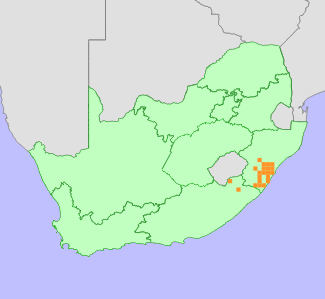|
Scientific Name | Haemanthus deformis Hook.f. |
Higher Classification | Monocotyledons |
Family | AMARYLLIDACEAE |
Synonyms | Haemanthus baurii Baker, Haemanthus mackenii Baker |
Common Names | Uzeneke (z) |
National Status |
Status and Criteria | Vulnerable B1ab(v) |
Assessment Date | 2022/07/24 |
Assessor(s) | V.L. Williams & N.R. Crouch |
Justification | This species has an extent of occurrence (EOO) of 17 900 km² and is severely fragmented and never abundant. The species only known to occur in forest patches close to the coast, therefore the area of occupancy (AOO) is likely to be restricted. The population is declining due to harvesting for the local medicinal plant trade. It therefore qualifies for listing as Vulnerable under criterion B. |
Distribution |
Endemism | South African endemic |
Provincial distribution | Eastern Cape, KwaZulu-Natal |
Range | This species is endemic to the KwaZulu Natal and Eastern Cape provinces of South Africa, where it stretches from the midlands and coastal areas of KwaZulu Natal to Mount Frere, near Tsitsa Falls and Gundrift. |
Habitat and Ecology |
Major system | Terrestrial |
Major habitats | Eastern Valley Bushveld, KwaZulu-Natal Sandstone Sourveld, KwaZulu-Natal Hinterland Thornveld, Moist Coast Hinterland Grassland, Dry Coast Hinterland Grassland, Northern Coastal Forest, Scarp Forest, Southern Mistbelt Forest, Northern Afrotemperate Forest, Lowveld Riverine Forest |
Description | Plants grow on forest margins, sheltered sites under bushes or on moist rocky banks and ledges. |
Threats |
| It is harvested for traditional medicine and has been recorded in the Durban traditional medicine markets (Cunningham 1988; von Ahlefeldt et al. 2003; N.R. Crouch, pers. obs., 2007). Cunningham (1988) described its conservation status as 'rare and vulnerable', i.e. a species with a relatively small population that was vulnerable to over-exploitation if harvesting for the traditional medicine trade continued. It was seen the first time in the Johannesburg markets in 2007 (V.L. Williams, pers. obs., 2007). In the Durban markets, there are about three or four traders that are known to sell the species; some of the traders sell 3-4 bulbs, while others are known to sell volumes of at least half a plastic supermarket shopping bag (N.R. Crouch, pers. comm., 2008). |
Population |
The species is generally only found in forest patches close to the coast and is never abundant, there will often only be 5-15 plants in a subpopulation (N.R. Crouch, pers. comm., 2008).
|
Population trend | Decreasing |
Conservation |
| It is protected in Krantzkloof Nature Reserve (Neil Crouch pers.obs.). |
Assessment History |
Taxon assessed |
Status and Criteria |
Citation/Red List version | | Haemanthus deformis Hook.f. | VU B1ab(v) | Raimondo et al. (2009) | |
Bibliography |
Bredenkamp, C.L. 2019. A flora of the Eastern Cape Province. Strelitzia 41. South African National Biodiversity Institute, Pretoria.
Cunningham, A.B. 1988. An investigation of the herbal medicine trade in Natal/KwaZulu. Investigational Report No. 29. Institute of Natural Resources, Pietermaritzburg.
Rabe, T. and van Staden, J. 1999. In vitro propagation of three Haemanthus species. South African Journal of Botany 65(5-6):483-440.
Raimondo, D., von Staden, L., Foden, W., Victor, J.E., Helme, N.A., Turner, R.C., Kamundi, D.A. and Manyama, P.A. 2009. Red List of South African Plants. Strelitzia 25. South African National Biodiversity Institute, Pretoria.
Snijman, D.A. 1984. A revision of the genus Haemanthus L. (Amaryllidaceae). Journal of South African Botany Supplement 12:1-139.
Von Ahlefeldt, D., Crouch, N.R., Nichols, G., Symmonds, R., McKean, S., Sibiya, H. and Cele, M.P. 2003. Medicinal plants traded on South Africa's eastern seabord. Porcupine Press, Durban.
|
Citation |
| Williams, V.L. & Crouch, N.R. 2022. Haemanthus deformis Hook.f. National Assessment: Red List of South African Plants version . Accessed on 2025/08/22 |
 Comment on this assessment
Comment on this assessment

